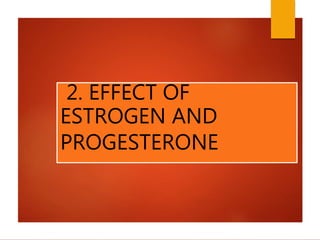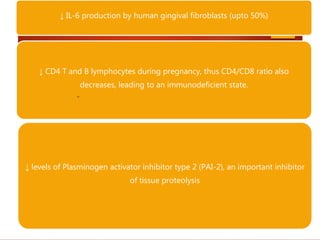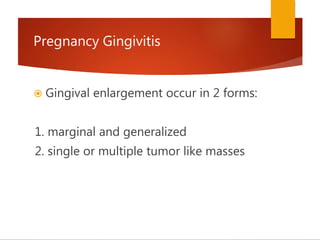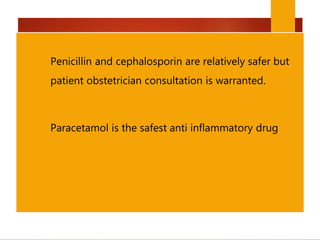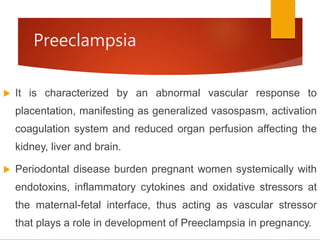Periodontal disease and pregnancy
- 3. INDEX EFFECT OF PREGNANCY ON PERIODONTAL TISSUES PREGNANCY GINGIVITIS EFFECT OF PERIODONTITIS ON PREGNANCY PRETERM LOW BIRTH WEIGHT (PLBW) INFANTS PREECLAMPSIA
- 5. PREGNANCY GINGIVITIS (INDEX) Pathogenesis Effect on Microbiota Effect of Estrogen and Progesterone Effect on Immune system Clinical Features Treatment
- 6. During pregnancy there is increased levels of sex steroid hormones Main estrogen in plasma in is estradiol; and main progesterone is progestin
- 7. By the end of 3rd trimester, plasma peak levels of these hormones are 100 ng/ml and 6ng/ml which is 10-30 times more than menstrual levels
- 8. PREGNANCY GINGIVITIS Gingival inflammation, initiated by plaque, and exacerbated by these hormonal changes in 2nd and 3rd trimester of pregnancy, is referred as Pregnancy Gingivitis. (seen in 30-100% cases) First described in 1877
- 9. Gingival inflammatory changes usually begin in 2nd month of pregnancy, and in severity to 8th month, after which there is abrupt decrease related to reduction of sex steroid hormone secretion.
- 10. PATHOGENESIS
- 12. . There is 55 fold increase in P. Intermedia in subgingival plaque Gestational hormones act as growth factors for P. Intermedia by satisfying the napthoquinone requirement bacteria
- 13. . Campylobacter level is directly related to estradiol level Bacteroides melaninogenicus also increases in pregnancy (55 fold) and in those taking contraceptives (16 fold)
- 14. 2. EFFECT OF ESTROGEN AND PROGESTERONE
- 15. Effect of Estrogen Estrogen stimulates proliferation of gingival fibroblasts, synthesis and maturation of the gingival CT. Cause increase in leakage of leukocytes and plasma proteins from post capillary venules by affecting the endothelial lining, contributing to enhanced gingival inflammation↓ Keratinization along with increase in epithelial glycogen results in decreased effectiveness of the epithelial barrier
- 16. Effect of Progesterone Increased Circulatory levels of Progesterone enhances capillary permeability and dilatation by forming gaps in endothelial lining of vessels, resulting in increased gingival exudate This increased gingival exudate effect caused by progesterone is of long duration as compared same effect produced by histamine that is of short duration.
- 17. Effect of Progesterone It inhibits collagenase activity thus resulting in accumulation of excess collagen in connective tissue, causing enlargement. Increased Progesterone levels ↓ the degree of keratinization of gingival epithelium
- 18. These hormones also rate of folate metabolism in oral mucosa. Since folate is required for tissue maintenance (DNA formation), increased metabolism could deplete folate stores and inhibit tissue repair. Thus folic acid tablet is always recommended in pregnancy
- 19. 3. EFFECT ON IMMUNE SYSTEM
- 20. . ↓ Neutrophil chemotaxis and phagocytosis, along with ↓ T-cell responses causes the suppression of immune system to plaque Progesterone in particular stimulates the production of inflammatory mediator PGE2 Peripheral blood lymphocytes showed a decreased response to bacterial antigens
- 21. . ↓ IL-6 production by human gingival fibroblasts (upto 50%) ↓ CD4 T and B lymphocytes during pregnancy, thus CD4/CD8 ratio also decreases, leading to an immunodeficient state. ↓ levels of Plasminogen activator inhibitor type 2 (PAI-2), an important inhibitor of tissue proteolysis
- 23. Pregnancy Gingivitis Gingival enlargement occur in 2 forms: 1. marginal and generalized 2. single or multiple tumor like masses
- 24. 1. Marginal enlargement Generalized enlargement, more prominent interproximally than on facial/lingual surface. Enlarged gingiva is bright red or magenta, soft, friable and has a smooth shiny surface Spontaneous bleeding or on slightest provocation
- 25. 2. Tumor like enlargement discrete, mushroom shaped, flattened spherical mass that protrudes from gingival margin / interproximal space Tends to expand laterally, and pressure from tongue and cheek perpetuate its flattened appearance Dusky red or magenta, with smooth, glistening surface that often exhibits numerous deep red, pinpoint markings.
- 26. Superficial lesion, that do not invade underlying bone. Usually painless, unless complicated by plaque accumulation. Site – anterior papilla of maxillary teeth (most common) Gingiva is involved in 70% of cases, followed by tongue, lips and buccal mucosa.
- 27. Histopathology Angiogranuloma Both marginal and tumor like enlargements consisting of central mass of CT with numerous diffusely arranged, newly formed engorged capillaries Chronic inflammatory infiltrate Thickened stratified squamous epithelium, with prominent rete pegs, intercellular bridges, and leukocytic infiltration.
- 28. TREATMENT Pregnant women need to be educated on the consequences of pregnancy on gingival tissues and thoroughly motivated in plaque control measures, with professional treatment as required. They are likely to be more comfortable to receive dental treatment during the second trimester than in the first or third trimester of pregnancy, although emergency treatment is permissible at any stage during pregnancy
- 29. Scaling and root planing Treatment of tumor like gingival enlargements consist of surgical excision The enlargement recurs unless all irritants are removed.
- 30. Penicillin and cephalosporin are relatively safer but patient obstetrician consultation is warranted. Paracetamol is the safest anti inflammatory drug
- 31. When to Treat Gingival lesions in pregnancy should be treated as soon as they are detected, although not necessarily by surgical means. 2nd trimester is the safest period of surgical excision. SRP and adequate oral hygiene measures may reduce the size of the enlargement. Gingival enlargements do shrink after pregnancy, but they usually do not disappear.
- 32. Lesions should be removed surgically during pregnancy only if they interfere with mastication or produce an esthetic disfigurement that the patient wishes to remove. After pregnancy, the entire mouth should be reevaluated, radiographs should be taken, and the necessary treatment undertaken. Emphasis should be on 1) preventing gingival disease before it occurs (by doing scaling in each trimester) and 2) treating existing gingival disease before it worsens.
- 33. EFFECT OF PERIODONTITIS ON PREGNANCY Preterm low birth weight (PLBW) infants Preeclampsia 33
- 34. Periodontal disease during pregnancy has been linked to preterm low birth weight (PLBW) infants, early pregnancy loss, and preeclampsia.
- 35. Preterm low birth weight (PLBW) infants
- 36. Preterm low birth weight (PLBW) infants Periodontitis is a remote gram negative infection that may play role in PLBW infants (PLBW < 2500gm) Premature and low-birth-weight (PLBW) infants are 40 times more likely to die during the neonatal period. Such infants who survive the neonatal period, face a higher risk of several neurodevelopment disturbances, health problems (such as asthma, upper and lower respiratory infections and ear infections) and congenital anomalies.
- 37. Offenbacher and co-authors in 1996 from a case controlled study suggested that women who delivered preterm low birth weight (PLBW) infants had poorer periodontal health than mothers with normal birth weight infants. They found the presence of higher levels of Porphyromonas gingivalis, Bacteroides forsythus, Actinobacillus actinomycetemcomitans and Treponema denticola organisms normally associated with periodontal disease in mothers of PLBW babies as compared to normal controls.
- 38. In periodontal disease, transient bacteremia can occur leading to selective colonization of undesired sites. Study by Han et al (2004) have shown that hematogenous injection of orally related F. nucleatum in mice resulted in preferential localization to placental blood vessels from which it crossed the endothelium to the amniotic fluid and induced premature delivery and stillbirths in a pattern similar to that seen in humans. This supports the hypothesis that after transient bacteremia, oral bacteria like F.nucleatum translocates to pregnant uterus and possibly to the fetus hematogenously.
- 39. Bacterial migration from periodontal tissues into blood circulation, also stimulate the production of inflammatory mediators and increased prostaglandin PGE2 production responsible for uterine contraction and the onset of preterm delivery. F. nucleatum and P. gingivalis had been isolated from amniotic fluid and cord blood in cases of preterm birth and neonatal sepsis by Gauthier S et al (2011) and Katz J et al (2009) respectively.
- 40. Proposed mechanisms are- Translocation of the periodontal bacteria to fetoplacental unit Systemic dissemination of endotoxins on fetoplacental unit Systemic dissemination of inflammatory mediators (IL-1, IL-6, TNF-α, PGE2) on fetoplacental unit.
- 41. MECHANISM: 41Periodontal Infection Bacteria & their products in amnion Inflammatory response with cytokine production in amnion Increased amniotic prostaglandin production Preterm labour with LBW infants
- 42. PREVENTION Hence periodontal disease appears to be an independent risk factor for PLBW (preterm low birth weight infants) and there is need to expand preventive measures by introducing oral health programs as an integral component of prenatal care for pregnant mothers.
- 43. Preeclampsia
- 44. Preeclampsia Preeclampsia is a pregnancy-specific disorder characterized by increase in systolic arterial pressure (≥140 mmHg) and/or diastolic pressure (≥90 mmHg) and proteinuria (≥300 mg/24 h), after 20 weeks of gestation. It is dangerous for both mother and fetus. Periodontitis is considered as a risk factor for it. Etiology: An increased systemic inflammatory response to pregnancy
- 45. Preeclampsia It is characterized by an abnormal vascular response to placentation, manifesting as generalized vasospasm, activation coagulation system and reduced organ perfusion affecting the kidney, liver and brain. Periodontal disease burden pregnant women systemically with endotoxins, inflammatory cytokines and oxidative stressors at the maternal-fetal interface, thus acting as vascular stressor that plays a role in development of Preeclampsia in pregnancy.
- 46. Normal pregnancy is considered as mild pro-inflammatory state whereas preeclampsia indicate more severe level of inflammation. The subgingival bacteria, their products and pro-inflammatory cytokines may enter the bloodstream, reach maternal–fetal interface, trigger/worsen maternal inflammatory response, increases prostaglandin and cytokines levels in the plasma, causing complications in pregnancy.
- 47. Prevention Maternal periodontal disease is a preventable disease in contrast to preeclampsia, which can be treated but is difficult to prevent. Hence, maternal periodontal disease must be taken as an independent risk factor for adverse pregnancy outcomes during evaluation of the pregnant women.
- 48. The study by Jaiman G et al (2018) showed that birth weight of newborn was significantly less in the preeclamptic group suggesting that maternal preeclampsia could increase risk for low birth weight infants.













